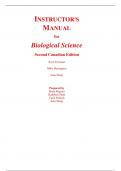Tentamen (uitwerkingen)
Instructor's Manual for Biological Science 2nd Canadian Edition By Scott Freeman Michael Harrington Joan Sharp (All Chapters, 100% Original Verified, A+ Grade)
Vak
Biological Science 2nd Can
Instelling
Biological Science 2nd Can
This Is Original 2nd Edition of Instructor Manual From Original Author. All Other Files in the market are fake/old Edition. Other Sellers Have changed old Edition Number to new But Instructor Manual is old Edition.
Instructor's Manual for Biological Science 2nd Canadian Edition By Scott Freeman ...
[Meer zien]
Voorbeeld 4 van de 630 pagina's
Geupload op
29 juli 2024
Aantal pagina's
630
Geschreven in
2023/2024
Type
Tentamen (uitwerkingen)
Bevat
Vragen en antwoorden
test bank exam bank mcqs solutions manual
test bank download free test bank download
free solutions manual answer key download
Instelling
Biological Science 2nd Can
Vak
Biological Science 2nd Can
€22,95
Ook beschikbaar in voordeelbundel v.a. €24,90
100% tevredenheidsgarantie
Direct beschikbaar na betaling
Zowel online als in PDF
Je zit nergens aan vast
Ook beschikbaar in voordeelbundel (1)
Instructor s Manual With Test Bank for Biological Science 2nd Canadian Edition By Scott Freeman Michael Harrington Joan Sharp (All Chapters, 100% Original Verified, A+ Grade)
1. Tentamen (uitwerkingen) - Test bank for biological science 2nd canadian edition by scott freeman michael harrin...
2. Tentamen (uitwerkingen) - Instructor's manual for biological science 2nd canadian edition by scott freeman mich...
Meer zien
INSTRUCTOR 'S MANUAL for Biological Science Second Canadian Edition Scott Freeman Mike Harrington Joan Sharp Prepared by Brian Bagatto




